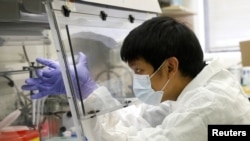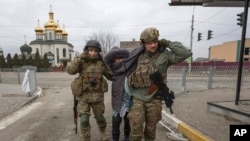On May 26, China’s state-run Global Times newspaper claimed that the U.S. is investing in building biological weapons in Central Asia:
“Funded by the United States Defense Threat Reduction Agency (DTRA), the Central Reference Laboratory near Almaty, Kazakhstan's most populous metropolis, is researching lethal pathogens that could be used in bio-terrorist attacks like plague and cholera, according to media reports.”
That is misleading.
This is a recurring conspiracy theory, pushed by Russia and China, about U.S. funding of biological research facilities around the world. While the Central Reference Laboratory in Kazakhstan does conduct research on lethal pathogens, its mission is to prevent these dangerous pathogens from being used as biological weapons or becoming the next pandemic, exactly the opposite of what the Global Times claimed.
Human activity is the main force driving newly emerging and re-emerging diseases. According to the World Bank, Central Asia is “particularly vulnerable to emerging infectious disease outbreaks as it is located at an intersection of global value chains with countries that rely heavily on labor migration.”
Historically, Kazakhstan monitored potential virus and diseases under former Soviet’s anti-plague system, which fell into disrepair after the collapse of the Soviet Union. The lack of funding and proper maintenance increased the possibility of lab leaks.
In response, Kazakhstan and the United States jointly agreed to build a national BSL-2 and BSL-3 laboratory, called the Central Reference Laboratory, or CRL, located in Almaty, a city of 2 million people.
In 2013, the United States Defense Threat Reduction Agency, or DTRA, and the Nunn-Lugar Cooperative Threat Reduction Program invested $102 million in the CRL.
The United Sates provided only financial support to build the lab, and Kazakhstan assumed full operational ownership of the facility on September 29, 2017.
According to Kazakhstan’s Foreign Ministry, the CRL is “fully owned by the Republic of Kazakhstan” and funded “solely from the republican budget.” The staff consists entirely of domestic specialists.
“We declare responsibly that no biological weapons development is underway in Kazakhstan, no research is conducted against any other states,” the ministry said.
In 2018, Zhandarbek Bekshin, then Kazakhstan’s chief sanitary doctor, told reporters that the main purpose of the lab was “to increase the technological and methodological possibilities of controlling especially dangerous infections and to conduct research to prevent mass epidemics in the country.”
In 2013, National Geographic quoted Lt Col. Charles Carlton, then director of the DTRA offices in Kazakhstan, as saying the facility would also help “giving stable employment to scientist who might otherwise be tempted to sell their high-level and potentially destructive knowledge to hostile groups.”
Currently, the CRL facility is housed in a four-story building with an area of 6,300 square meters. It includes a BSL-2 and a BSL-3 lab, both of which have been designed to current international standards for biosafety and biosecurity.
Scientists say there are risks involved in researching dangerous biological agents, such as Crimean Congo hemorrhagic fever (CCHF), hemorrhagic fever with renal syndrome (hantaviruses), tickborne encephalitis (TBE), rickettsial diseases and Q fever. One review identified more than 1,000 laboratory-acquired infections over a 25-year period.
Yet, according to an article published by two bioweapon experts — Andy Weber, senior fellow at the Council on Strategic Risks, Janne E. Nolan Center on Strategic Weapons and Richard Pilch, director of the Chemical and Biological Weapons Nonproliferation Program, Middlebury Institute of International Studies at Monterey, California — replacing the outdated Soviet-era facility in Kazakhstan with a facility built to international standards “has unequivocally reduced the risk of both natural infectious disease and laboratory accidents that might impact the region and world.”
Still, experts say that biolabs like CRL are inherently dual use. The same biological agents required for scientific research could have weapons-related applications.
To address that concern, Kazakhstan regularly submits confidence-building measures reports to demonstrate its compliance with the 1972 Biological Weapons Convention. The convention, signed by 185 countries, “prohibits the development, production, acquisition, transfer, stockpiling and use of biological and toxin weapons,” according to the United Nations.
A paper published by the Frontiers in Public Health journal in 2021 studied joint programs between Kazakhstan, the United States, Britain and Germany. It concluded that cooperative bio-research programs in Kazakhstan, including CRL, “have resulted in better collaboration, increased communication, and significant investment in building scientific research capabilities in Kazakhstan.”
The study said that Kazakhstan’s scientists confirmed they now more frequently participate in international conferences and have a greater number of peer-reviewed publications in international journals.






